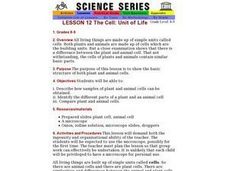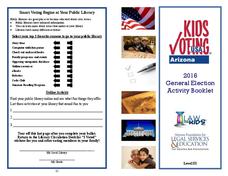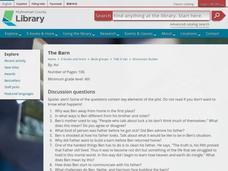Curated OER
Japanese American Internment
Students create a presentation based on the primary sources they have researched about the Japanese Americans that were held in internment camps during World War II. In this Japanese Americans lesson plan, students read different points...
Curated OER
The Art of "Green" Flying
Students create an airship that doesn't use fossil fuel. In this flying lesson, students research different types of flying machines that only use wind power. They discuss invention designs by Alexander Graham Bell and Leonardo Da Vinci...
Curated OER
Driving Through History
Students create and perform a skit. In this automobile history lesson, students work in groups to research the development of the automobile during different periods of history. Students create a timeline and perform a skit that...
Curated OER
Making a Travel Brochure of a Louisiana Parish
Although the attachments for this travel brochure project are no longer linked, you can still use the idea here and create your own assignment sheet and rubric. Learners choose a parish in Louisiana (or a city in your state) to research,...
Curated OER
Learning a New Environment
Students review a school map with color-coded markers and use it to locate classrooms, bathrooms, library, principal's office, etc. They color a school map, cut it into puzzle pieces and then reassemble the pieces.
Curated OER
The Foods We Eat: Towards a Balanced Diet
Students list at least 10 different food items grown/produced in their community, identify what each food item contains and make a list of different food items which constitute a balanced diet. They bring in food samples and write food...
Curated OER
What is An Insect?
Students investigate the concept of an insect. They conduct research about six different insects and identify the different body parts. Students look at the life cycle of the developing monarch butterfly. They also use the library to...
Curated OER
Under The Sea
In this resource instructional activity, learners use non-fiction books to research ocean animals. Students discover the many features of non-fiction books and how to use these features to help them conduct research. Learners then...
Curated OER
The Cell: Unit of Life
Students identify the parts of plant and animal cells, how samples can be obtained and what the differences are.
Curated OER
Immigration For Grades 3-5
Students engage in a lesson that is concerned with the concept of immigration. They conduct research using a variety of resources. Students create a KWL chart to organize the information. The lesson also includes a resource link for the...
Curated OER
Rocks, Minerals, and Fossils
Fourth graders do 5 different lab stations to explore rocks, minerals, and fossils.
Curated OER
Inventor's Project
Students conduct research about different inventors and their inventions. They use various types of resources to obtain information. Students use the information to create a class museum that contains artifacts, written reports, or models.
Curated OER
Past and Present: Using baseball statistics to teach math
Students use baseball cards to add up batting average and reinforce math skills. In this batting averages lesson plan, students use old baseball cards to practice different math skills and look at other baseball statistics.
Curated OER
Polygons
In this polygons worksheet, students name each polygon, and state how many vertices and sides each one has. Students do this for 8 different polygons.
Curated OER
Vertical Tower
In this trigonometry worksheet, 11th graders are given a tower built by different angles and asked to prove the sides are true using the theorems of trig angles. There are 3 questions with an answer key.
Curated OER
Understanding URLs
Ninth graders explore the different domain suffixes in the web site address, how to find the author or sponsor of a page to determine authority and accuracy. They determine how currency of a page. Students enter the lab, log onto...
Curated OER
Gearing Up for Wi-Fi Life
Students discover how wi-fi works in walkie talkies and computers. They also examine wi-fi wireless network coverage areas and campus locations in which data was taken to measure usage. They complete graphs based on the usage for...
US National Library of Medicine
Basic Genetic Concepts and Terms
Have you ever wondered why you aren't taller or invisible? It all comes down to your dominant and recessive genes. Introduce your class members to genetics with a presentation that includes worksheets for young geneticists to complete...
Law for Kids
General Election Activity Booklet
It's never too early to practice smart voting! Gain practice voting in a general election using a booklet compiled of an assortment of activities including a word search, maze, graphing, and more!
Library of Congress
Marco Paul's Travels on the Erie Canal: An Educational Voyage
Following the book, Marco Paul's Travels on the Erie Canal, readers complete an activity for each chapter, take part in discussions, and respond to several questions. To show what they know, scholars create an alphabet book using primary...
Library of Congress
Stars, Stripes and Symbols of America: Comparing Our Flag, Past and Present
Your young historians will compare and contrast the details of the American flag today with an an image of the nation's flag from the post-Civil War era, and identify the flag's importance as a national symbol through analysis worksheets...
Multnomah County Library
The Barn: Discussion Questions
After reading The Barn by Avi, learners look over a list of discussion questions about the plot of the story. The discussion guide is a great way to engage readers in the book as well as to open up a thoughtful discussion about what they...
Red River Press
Remembrance Day, Lest We Forget
Have we forgotten? As part of their study of Remembrance Day, class members consider whether countries have kept their promise not to forget and create their own remembrance ceremony.
University of California
The Civil War: Effects of the Civil War
Imagine being on the front line of the Civil War —from the front porch of your own house. Scholars use visual evidence from primary and secondary sources to analyze the impact of the Civil War on all Americans. They examine the research...

























